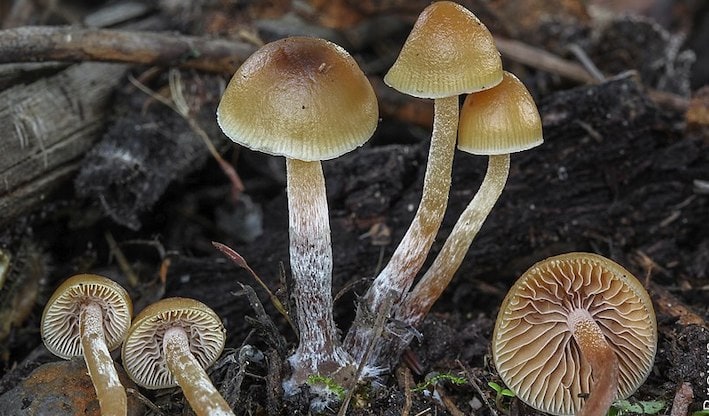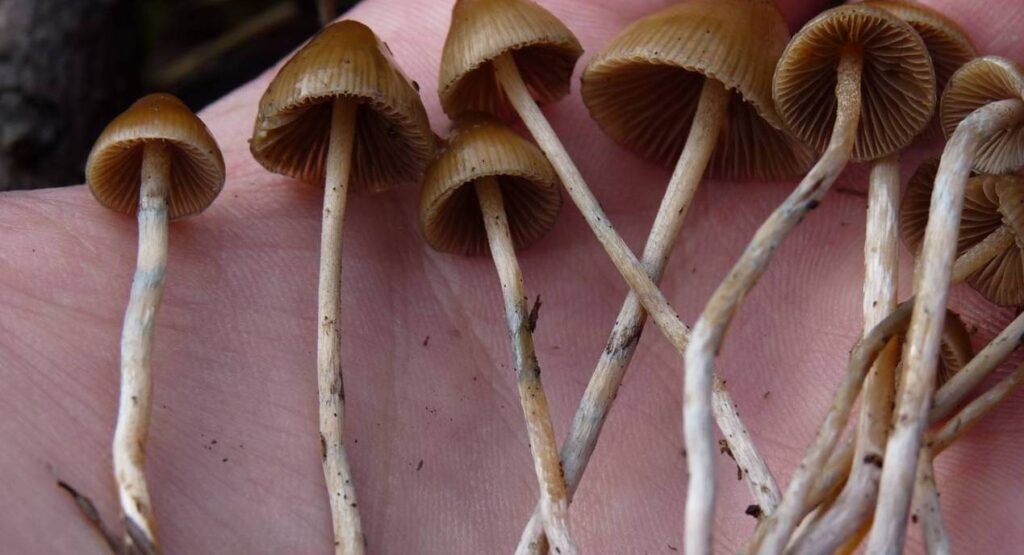The American mycologist Alexander H. Smith first officially identified this mushroom in 1937. He described them as Psathyra pelliculosa, based on specimens he had found in Oregon and Washington. The ‘type specimen’, he collected in 1935, close by Tahkenitch Lake, Oregon. Later, in 1941, Smith reclassified his specimen as Hypholoma silvatica (later Psilocybe silvatica), as he thought that the slight differences between the mushrooms were not significant to warrant being a new species.

The Psilocybe Pelliculosa Earns a Name
Fast forward to 1958, and Smith, along with fellow mycologist Rolf Singer, reevaluated it transferring it to Psilocybe, and returning the taxon of pelliculosa. Gastón Guzmán, a Psilocybe expert, put P. pelliculosa in the Semilanceata section, a group of related species with similar characteristics.
Of course, the Psilocybe genus means one thing, and that’s the presence of psychoactive compounds psilocybin, psilocin and baeocystin. However, its concentration is relatively weak. Although you’d still trip out if you consumed it, its psychoactivity is dwarfed by its cousins such as Psilocybe semilanceata (or Liberty Cap), coming in (according to Paul Stamets) at only ⅕ to 1/20 of its potency. This makes the P pelliculosa a popular shroom for microdosers, making its comparable ‘weakness’ a strength. (Don’t get it twisted though — this is still a psychoactive mushroom — be warned!)

Where and When?
Psilocybe pelliculosa hails from the Pacific Northwest of the US and Canada, though small amounts have been spotted in Norway and Finland. They tend to favour land that has been disturbed, i.e beside forest roads and pathways, growing in clumps of moss and woody debris. They tend to fruit in early winter, after damp, cool weather. In the 1960s there were reports of the P. pelliculosa losing its psychoactive properties when grown in a lab, making it seem as though this is a mushroom that demands to be free-range.

Look-Alikes
As a rather generic looking mushroom, the P. pelliculosa has a few doppelgangers. It is pretty close to those of the genus Mycena, Galerina and Hypholoma. There is also, as we mentioned before, the Liberty Cap mushroom — a much more potent psilocybe. These can be told apart by experienced shroom hunters via the Liberty Cap’s larger spores and more conical-shaped cap. If you confuse these two, you will certainly get more than you bargained for psychedelically, which while not desirable, is far better than if you mistake pelliculosa for one of its evil twins. Both the Galerina and Pholiotina mushrooms are deadly to humans, with sky-high toxicity levels. So, if in doubt, leave well alone. (And get yourself a grow kit!)
What’s In A Name?
The name pelliculosa comes from the Latin word ‘pellicula’ which means ‘film’. This refers to the gelatinous coating (pellicle) of the cap (see, we told you it was slimy!) This mushroom is also known as the ‘conifer Psilocybe’, due to its preference for coniferous forests, or the ‘striate Psilocybe’.
Vital Stats: How to Spot This Shroom!
To identify a Psilocybe pelliculosa, check out the following:
Cap: conical, flattening over time to a bell-shape — however, unlike some shrooms, it never becomes totally flat. The cap is sticky and smooth, with translucent lines or furrows (striations) that radiate from the centre. The colour varies from reddish-brown to pale grey-yellow and when dried to a pale pink-beige.
Gills: the gills can range from narrow to slightly broader, are closely spaced, and after a time separate themselves from the stem. In youth they are umber in colour, but with paler edges, which darken over time, due to their covering of dark spores.
Spores: the spores are dull purple-brown, and the spore print similar. They are an oval to egg-like shape.

Stem (or stype): the stem ranges between 6 to 8cm in length and 0.06 to 0.08cm in width. The base is slightly wider and has a brownish hue, and silky ‘hairs’. The upper portion of the stem is grey and suited with a white powder (pruinose). The presence of psilocybin causes the mushroom flesh to turn a bluish-green.
Taste and Smell: The taste and smell of the Psilocybe pelliculosa is described as farinaceous which means ‘containing starch’. Apparently similar to freshly ground flour.
Can I eat it? : It is edible, but hallucinogenic. Proceed with caution
Find it: In moss and mulch on the side of forest roads and walkways.

When: Early winter, after a damp fall.
Family: Hymenogastraceae
Genus: Psilocybe
Species: pelliculosa





